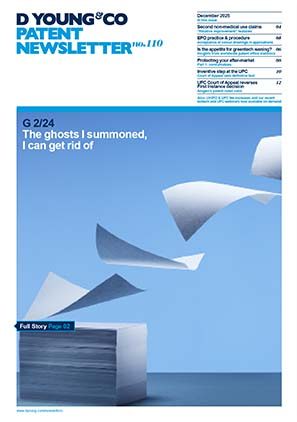EPO: Revised Guidelines for Examination in force 01 November 2019
The revised EPO Guidelines, for Examination provide guidance for examiners and applicants on European patent law and procedure. The revisions clarify, in a number of important areas, how applications should be treated before the EPO. Some of the most notable changes are discussed in this article. Guideline references of the form A-IV, 2 refer to Chapter A, part IV, section 2.
Reasoned objections (C-III, 4.1.1)
An amendment has been made regarding reasoned objections to clarify that when raising patentability objections against an application, the burden of proof lies with the Examining Division. They must provide evidence and facts to support their objection (T 655/13). Prior art documents must be cited so that these conclusions can be checked without difficulty. This change ensures that examiners cannot raise unsubstantiated objections.
Divisional applications (C-IX, 1.1)
The Guidelines as amended clarify that proceedings for grant of a divisional are separate and independent from that of a parent. Adjournment of examination of a divisional application by the EPO of its own motion, or on request, is not possible pending opposition/appeal hearings concerning the parent/other family member. Allowable reasons for a stay or interruption of proceedings are set out in E-VII, 1, to E-VII, 3.
International applications in the regional phase (E-IX)
Further details have been included in the Guidelines regarding the treatment of an international application during the European regional phase and procedures to be completed when entering the European regional phase. These are largely taken from the Articles and Rules of the PCT. This extra information in the Guidelines makes them a useful reference for applicants in particular situations such as restoration of priority or review and rectification of errors by the Receiving Office/International Bureau.
Inclusion of parameters in the claims (F-IV, 4.11)
Further details have been included in the Guidelines regarding the use of parameters/characteristics in the claims. Specifically, the Guidelines state that characteristics in the claims may be specified by parameters related to the physical structure of the product. The parameters must be clearly and reliably determined by objective procedures which are usual in the art. In order to fulfil the requirements of Article 84 EPC for the characterisation of a product by parameters:
- The claims must be clear in themselves when read by the skilled person (not including knowledge derived from the description);
- The method for measuring a parameter (or at least a reference thereto) must appear completely in the claim itself; and
- the skilled person must be able to easily and unambiguously verify whether they are working inside or outside the scope of the claim.
The Guidelines then go on to state that if the description of the method for measuring a parameter is so long that it would obscure the clarity of the claim, then a reference to the description can be included in the claim. Alternatively, if there is only one method of measuring the parameter or all methodologies yield the same result, it does not need to be included in the claim.
Product claims with process features (F-IV, 4.12.1)
The Guidelines as amended now include a section (F-IV, 4.12.1) directed specifically to product claims with process features. This section states that a claim defining a product and comprising product features and process features does not contravene Art. 84. The novelty assessment is the same for these claims as product-by-process claims. Specifically, process features establish novelty only if they cause it to have different properties from the products previously described. The burden of proof regarding this lies with the applicant.
Interpretation of means-plus-function features (F-IV, 4.13.2)
The Guidelines as amended now include a section (F-IV, 4.13.2) directed specifically to the interpretation of means-plus-function features. The section states that means-plus-function features (“means for ...”) are functional features and therefore do not contravene Article 84 EPC. When considering patentability of these features, any prior art features which are suitable for carrying out the function of a means-plus function feature will anticipate that feature of the claim.
The Guidelines then highlight an exception to this in which the function of the means-plus-function feature is carried out by a computer. In this situation, the means-plus-function features are interpreted as means adapted to carry out the relevant steps/functions, rather than merely means suitable for carrying them out. Thus, in order to anticipate a claim, a prior art document must disclose an apparatus which carries out the claimed steps rather than merely an apparatus suitable for carrying out the steps. This is likely to have an effect on the patentability of computer implemented inventions which are often claimed as methods for carrying out a purpose.
Mathematical methods – technical implementations (G-II, 3.3)
The updates to the Guidelines include an additional comment regarding the technical effect of mathematical methods. If a mathematical method produces a technical effect when applied to a field of technology and/or adapted to a specific technical implementation, the computational efficiency of the steps affecting that established technical effect are taken into account when assessing inventive step. Therefore the efficiency of an algorithm will contribute when assessing inventive step. The EPO therefore seems to be acknowledging the effects that efficient algorithms can make. This may make it easier to argue the patentability of inventions in this field.
Mathematical methods – AI and machine learning (G-II, 3.3.1)
Further comments have been included with respect to AI within the section on mathematical methods. Previously, the expressions “support vector machine”, “reasoning engine” or “neural network” were written as referring to abstract models devoid of technical character. The Guidelines now state that these expressions may, depending on the context, merely refer to abstract models or algorithms and thus do not, on their own, necessarily imply the use of a technical means. The Guidelines then state that this has to be taken into account when examining whether the claimed subject matter has a technical character as a whole. It therefore seems that the EPO are recognising the potential for patentable inventions in this area.
Programs for computers (G-II, 3.6)
As for section (G-II, 3.3), updates have been made to state that if a further technical effect of the computer program has already been established, the computational efficiency of an algorithm affecting the established technical effect contributes to the technical character of the invention and thus to inventive step. An example of this is provided where the design of the algorithm is motivated by technical considerations of the internal functioning of the computer (for example the efficient functioning of the computer). As with the changes to the mathematical methods section, these may make it easier to argue the patentability of inventions in this field.
Plant and animal varieties (G-II, 5.4)
Further information has been included in the Guidelines relating to the patentability of plant and animal varieties. Specifically, the Guidelines state that for living matter to be patentable, it must be reproducible in a way that has exactly the same technical features. Reproducibility can be assured by:
- Deposit of the living matter (this must be publically available and the skilled person must be able to reproduce the invention starting from it).
- Disclosing in the application the gene sequence responsible for the claimed trait and instructions on introducing altered sequence in a target organism.
Additional information has also been included regarding exclusions from patentability. Controlled hybrids with inbred parents are excluded from patentability as they define either a seed or a plant which necessarily belongs to a particular plant grouping within the meaning of plant variety pursuant to Rule 26(4). Plant varieties are excluded under Article 53(b) EPC and this exclusion cannot be avoided by drafting a claim to a large number of varieties. If a claim comprises at least one embodiment which does not constitute a variety, it is allowable under Article 53(b) EPC.
Selection inventions (G-VI, 8)
Previously, in order for a subrange selected from a broader numerical range to be novel, the following three criteria needed to be satisfied:
- the selected sub-range is narrow compared to the known range;
- the selected sub-range is sufficiently far removed from any specific examples disclosed in the prior art and from the end-points of the known range; and
- the selected range is not an arbitrary specimen of the prior art, that is, not a mere embodiment of the prior art, but another invention (purposive selection, new technical teaching).
In the updated Guidelines, the third requirement has been deleted. Thus the test for novelty of sub-ranges has been simplified and has moved away from the previous inventive step-like assessment required due to the third step of the test. Thus it will likely be easier to demonstrate the novelty of the claim with a sub-range. This is likely to have a particular effect on the chemistry and pharmaceutical field.
Inventive step in biotechnology (G-VII, 13)
Additional information has been included regarding the inventive step of biotech inventions. Inventions are considered obvious when results are predictable and when there is a reasonable expectation of success. To render a solution obvious, it is sufficient for the examiner to establish that the skilled person would have followed the teaching of the prior art with a reasonable expectation of success.
The Guidelines also state that “a reasonable expectation of success” is not the same as the “hope to succeed”. If researchers are aware when embarking on their research that, in order to reach a technical solution, they will need not only technical skill but also the ability to make the right nontrivial decisions along the way, it is stated that this cannot be regarded as a “reasonable expectation of success”. This clarifies the application of the could-would approach.
Deletion of claimed subject matter (H-V, 3)
The old Guidelines defined a three step test for the allowability of amendments by removal or replacement of features. This was as follows:
the replaced or removed feature was not explained as essential in the originally filed disclosure;
the skilled person would directly and unambiguously recognise that the feature is not, as such, indispensable for the function of the invention in the light of the technical problem the invention serves to solve; and
the skilled person would directly and unambiguously recognise that the replacement or removal requires no modification of one or more features to compensate for the change.
The wording “directly and unambiguously” has now been taken out of the third step. Thus, this step now reads “the skilled person would recognise that the replacement or removal requires no modification of one or more features to compensate for the change”. It is likely that this will make it easier to make amendments by removal or replacement of features.
The Guidelines have also been updated regarding the deletion of alternatives from more than one list. Under the revised Guidelines this is now allowable only if this does not result in the creation of new technical information that is not directly and unambiguously derivable from the application as originally afiled. Furthermore, if a limitation does not result in the singling out of a particular combination of specific features, but maintains the remaining subject-matter as a generic group which differs from the original group only by its smaller size, it is stated as also usually being allowable. A combination of specific features may be allowable if the application as filed provides a pointer towards that particular combination, for example, by reference to preferred embodiments. These principles also apply to the combination of features resulting from dependent claims.

